
Wine Culture Magazine

George and Trudy Heiss pictured at Gray Monk Estate, the winery they built despite the skeptics, overlooking Okanagan Lake. Photo courtesy of Gray Monk
The news of George Heiss Sr.’s passing, on June 29, left me feeling particularly sad. Even though a few years have gone by since George and his wife, Trudy Heiss, sold Gray Monk to Andrew Peller, for me Gray Monk past, present and future will always remain theirs in spirit.
I know it’s a romantic notion. But I like to imagine that, somehow, even as we inevitably lose our pioneers, future generations will have more than an inkling of the supreme effort it took by a very few to launch the industry we now take for granted.
To fully appreciate the challenges faced by this entrepreneurial couple and the very small cadre of believers at the time, it pays to put things in context. It was the mid 1970s when George and Trudy Heiss left Edmonton (where they were well-established hairdressers) to pursue an uncertain future in Okanagan Centre. Their mission was to pursue grape growing—at the time a relatively unproven industry.
Trudy’s father, Hugo Peter, had moved to the Okanagan in 1968 and purchased a peach orchard, which he later converted to hybrid grapes with good results. It was he who suggested a career change might be in order. Motivated by Peter’s success on the steep, southwestern-facing slopes 300 feet above Okanagan Lake, George and Trudy planted their own vines, initially seven acres of Marechal Foch and Rosette, in time becoming contract growers for Ste. Michelle.
Not content to remain as growers facilitating others’ winemaking efforts, they were determined to establish their own winery—which, at the time, was unprecedented, as only major producers dominated the winemaking landscape. It was a daunting task, especially considering the reluctance of the government to support any deviation from the norm, which was, in essence, to facilitate only bulk wine production.

Not only were Trudy and George Heiss among the early B.C. wine industry’s
most passionate and optimistic supporters, they are recognized as the most hospitable, too. Tim Pawsey photo
Nevertheless, George and Trudy channelled their trademark passion and enthusiasm to help them succeed on their new journey. Firm believers from the beginning that B.C. should and could compete with the world’s greatest wine-growing regions (and buoyed by the results of the Becker Project , which tested the viability of 33 vitis vinifera varieties), they planted vinifera. Then they relentlessly pressured the provincial government to develop what would become farmgate (and later estate) winery models that ultimately formed the foundation for today’s industry.
They wholeheartedly embraced the notion that the only way forward involved growing premium vinifera—including their namesake Pinot Gris—known in Austria as “Gray Monk.” After earlier help from John Bremmer and Lynn Stark, first in Similkameen Vineyards’ machine shop and the next year in their garage, they made their first commercial vintage in 1981. Their fresh and fruit-driven style soon commanded a loyal following, which survives to this day.
However, also no longer widely appreciated is the role that George Heiss played in selflessly sharing his newly gained knowledge with other neophyte growers, ultimately paving the way for the early foundation of B.C.’s new “vinifera” era that coalesced with the passing of the Free Trade Agreement and “great pull-out” of the late 1980s.
Germanic varieties, such as Pinot Auxerrois, Ehrenfelser, Kerner, Rotberger, Riesling and others—along with Pinot Gris—were Gray Monk’s foundation. But they also became the pillars of the early B.C. industry. It was very much driven by their success—and their role in convincing a previously skeptical public that the province could indeed make worthy wines.
Anyone who had dealings with Gray Monk over the years has also experienced George and Trudy Heiss’s legendary hospitality. Not to mention George’s irrepressible good humour (and unending bad jokes).
Okanagan Crush Pad owner (and inaugural executive director of the BC Wine Institute) Christine Coletta points to George’s background as a hairdresser as playing a key role in Gray Monk’s success.
“George was trained as a hairdresser, but successfully transferred his people skills—and his firm conviction that anything could be changed or fixed with time and hard work—to the highly successful establishment of Gray Monk Cellars,” says Coletta. She’s also quick to point out that George swayed public perception about the quality and value of Okanagan wine, with “positivity as large as his stature.”
Today’s booming B.C. industry (with now some 284 licensed grape wineries) bears small resemblance to the handful of estate wineries that emerged on the Okanagan landscape of the early 1980s. Such a remarkable transformation happened in great part thanks to the enduring vision and determination of George and Trudy Heiss.

Tim Pawsey writes and shoots at hiredbelly.com as well as for publications including Quench, TASTE and Montecristo. He’s a frequent wine judge and is a founding member of the B.C. Hospitality Foundation.

Tim Pawsey writes and shoots at hiredbelly.com as well as for publications including Quench, TASTE and Montecristo. He’s a frequent wine judge and is a founding member of the B.C. Hospitality Foundation.
@ Vitis Magazine